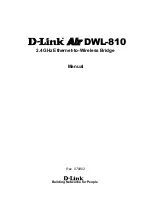
INS_CWGE24MS2_REV–
10/05/16 PAGE 175
INSTALLATION AND OPERATION MANUAL
CWGE24MS2
TECH SUPPORT: 1.888.678.9427
manual enabling/disabling of these backup links. Bridge loops must be avoided because they
result in flooding the network.
The Spanning Tree Protocol (STP) is defined in the IEEE Standard 802.1D. As the name suggests,
it creates a spanning tree within a mesh network of connected layer-2 bridges (typically Ethernet
switches), and disables those links that are not part of the tree, leaving a single active path
between any two network nodes.
STP switch port states
» Blocking - A port that would cause a switching loop, no user data is sent or received but it may
go into forwarding mode if the other links in use were to fail and the spanning tree algorithm
determines the port may transition to the forwarding state. BPDU data is still received in
blocking state.
» Listening - The switch processes BPDUs and awaits possible new information that would cause
it to return to the blocking state.
» Learning - While the port does not yet forward frames (packets) it does learn source addresses
from frames received and adds them to the filtering database (switching database)
» Forwarding - A port receiving and sending data, normal operation. STP still monitors incoming
BPDUs that would indicate it should return to the blocking state to prevent a loop.
» Disabled - Not strictly part of STP, a network administrator can manually disable a port
802.1w RSTP
In 1998, the IEEE with document 802.1w introduced an evolution of the Spanning Tree Protocol:
Rapid Spanning Tree Protocol (RSTP), which provides for faster spanning tree convergence after
a topology change. Standard IEEE 802.1D-2004 now incorporates RSTP and obsoletes STP. While
STP can take 30 to 50 seconds to respond to a topology change, RSTP is typically able to respond
to changes within a second.
RSTP bridge port roles:
» Root - A forwarding port that is the best port from Nonroot-bridge to Rootbridge
» Designated - A forwarding port for every LAN segment
» Alternate - An alternate path to the root bridge. This path is different than using the root port.
» Backup - A backup/redundant path to a segment where another bridge port already connects.
» Disabled - Not strictly part of STP, a network administrator can manually disable a port
Edge Port:
They are attached to a LAN that has no other bridges attached. These edge ports transition
directly to the forwarding state. RSTP still continues to monitor the port for BPDUs in case a bridge
is connected. RSTP can also be configured to automatically detect edge ports. As soon as the
bridge detects a BPDU coming to an edge port, the port becomes a non-edge port.
Forward Delay:
The range is from 4 to 30 seconds. This is the maximum time (in seconds) the root device will wait
















































